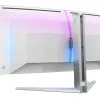Product Showcase
Mounting the unit takes a few moments and is not a challenge - screw the base and leg together and clip the whole piece into the snap-on mount. The monitor weighs 9kg, including the stand, which is quite massive, but that’s as much as 27-inch monitors can weigh.
Clipping the cables in beforehand is a good idea, and route them to the back of the leg with a special holder. There is an air vent system at the top of the screen.
It is a good solution because the Philips Evnia 34M2C8600 uses an internal power supply.
The interface pampers but is a little short of perfect. Unfortunately, the two HDMI ports are version 2.0, which supports native resolution but only at 100 Hz. It is a pity that HDMI 2.1 is not used, which would benefit consoles. Therefore, connecting a desktop PC via DisplayPort 1.4 is better, enabling full resolution at 175 Hz and 10-bit color depth.
USB-C is multifunctional. The port allows a video signal output from a laptop (DP Alt Mode) and charges mobile devices up to 90 W (Power Delivery 3.0). The connector supports native resolution and 175 Hz, but in 8-bit. It doesn’t stop there, as the monitor has built-in KVM, meaning it recognizes multiple connected devices and can switch between them. It’s great that two of the four USB-A ports are easily accessible, as they are located on the edge just below the Evnia logo. The USB-A ports, in particular, are very close to each other in pairs, but the distribution is otherwise okay.








